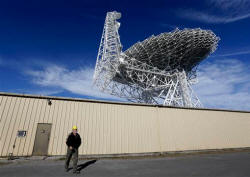 |
|

 Science
in silence in Radio Quiet Zone
Science
in silence in Radio Quiet Zone
[December 02, 2013] GREEN BANK, W.Va. (AP) — In these parts, a pay phone is a visitor's best option for reaching the rest of the world. A cellphone signal is an hour away by car. Wi-Fi is forbidden. The radio plays nothing but static. And other than the occasional passing pickup truck whose driver offers a wave, it's dead silent.
|
Seemingly off the beaten path, this community of
fewer than two hundred residents is the heart of the National
Radio Quiet Zone, a 13,000-square-mile area where state and
federal laws discourage the use of everyday devices that emit
electromagnetic waves. The quiet zone aims to protect sensitive
radio telescopes at the National Radio Astronomy Observatory, as
well as a nearby Naval research facility, from man-made
interference. This silence enables the observatory to detect
energy in outer space that is equivalent to the energy emitted
by a single snowflake hitting the ground. While scientists listen intently for clues from the universe on
its structure and origins, residents in some of the timeworn
railroad towns in this valley maintain a fundamentally tech-less
lifestyle that for most Americans is a memory. More than 90
percent of
American adults have a cellphone today, yet some locals fondly
recall ditching their wireless device after moving here. After
all, it's useless, and that's fine by them. [Associated Press; PATRICK SEMANSKY] Follow AP photographers and photo editors on Twitter: http://apne.ws/15Oo6jo. Copyright 2013 The Associated Press. All rights reserved. This material may not be published, broadcast, rewritten or redistributed.
|
 |
|
|
|

